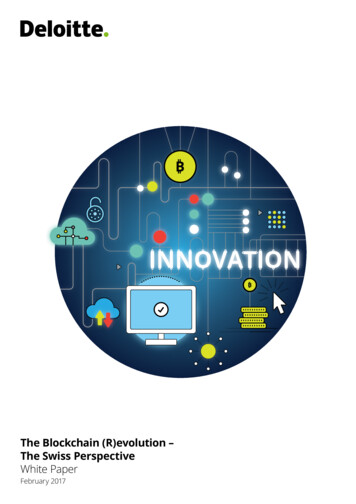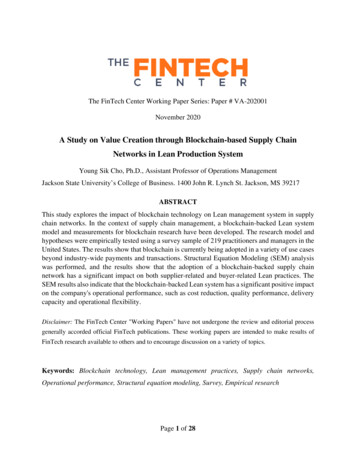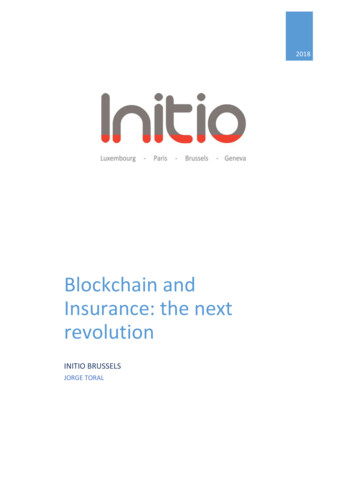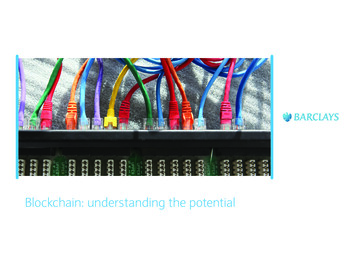
Transcription
THE BLOCKCHAINREVOLUTION 2020IN BANKS AND FINANCIALINSTITUTIONS
The Blockchain Revolution in Banks and Financial InstitutionsAUTHORSRuslan YusufovAlexander AnichkinEvgeny SolovievManaging Partner,MINDSMITHPartner,Head of the Russian Tech Group,Clifford Chance MoscowCounsel,Tech Group, Clifford ChanceMoscowEkaterina MakarovaKsenia KasyanovichGleb BorisovSenior Associate,Tech Group, Clifford ChanceMoscowDevelopment Director,MINDSMITHAnalyst,MINDSMITHEXPERT PANELAinur Zhanturina2Alexey ArkhipovHead of the FinTech CompetenceCentre of the AstanaInternational Financial CentreCEO, QIWI BlockchainTechnologiesHerbert ShopnikOleg ShibanovDirector of BusinessDevelopment, S7TechLabDirector of the Centre for Researchon Financial Technologies andDigital Economy, SKOLKOVO-NESAnatoly KonkinHead of Development of DistributedRegistry Technology, FinTechAssociation
The Blockchain Revolution in Banks and Financial InstitutionsRESEARCHPARTNERSMINDSMITH focuses on research, intensive educationalcourses, and strategic consulting in the field of hightechnologies.We speak the languages of business and technology andcan translate from one to the other. This is how we solvethe most difficult puzzles.We have our own Analytics Department and access to thenecessary expertise around the world to tailor individualsolutions in each particular case.Clifford Chance is one of the world’s leading law firms,with a single international team represented on fivecontinents. Clifford Chance’s clients include companiesrepresenting all key sectors of the economy, as well asregulatory agencies and non-profit organisations.Clifford Chance’s Tech Group brings together more than400 highly skilled specialists worldwide (talkingtech.cliffordchance.com) and is a leader in legal adviceon blockchain and other rapidly developing digitaltechnologies. Tech Group specialists have all theknowledge and resources necessary to implementmodern high-tech projects.3
The Blockchain Revolution in Banks and Financial InstitutionsOPENING STATEMENT 1More than 20 years ago, Bill Gates said: «Banking servicesare necessary, but banks are not.»Financial institutions are under enormous pressure today:the needs of new, digitally savvy, generations of customersare changing, compliance with business rules requiresmore and more expense, and innovative fintech projectsare targeting a significant piece of the pie.Financial institutions understand that they must change.That being said, the changes may affect not only productofferings, but may also lead to a significant change in theroles of organisations themselves.We cannot look behind the scenes of the research anddevelopment departments of financial institutions,because this is a trade secret. But based on variousindirect signs, we can draw conclusions about where thesestructures see themselves in five-ten years.When it comes to digital transformation, we can generallyassume several scenarios: you can come up with aninnovative solution yourself; you can buy it on the market;or you can buy a company with all its innovations and bestpractices.Taking into account these three scenarios, we analysedthe work with blockchain technology in the world’s largestfinancial institutions. We studied their patents and patentapplications («come up with it yourself»), their case studies(«buy on the market»), and their investments («buy acompany»).In this study, we discuss what such attempts by financialinstitutions to «reinvent» themselves might lead to: whatnew roles they might play, what markets might appear,and how the balance of power in the financial industrymight change.4Ruslan YusufovManaging Partnerof MINDSMITH
The Blockchain Revolution in Banks and Financial InstitutionsOPENING STATEMENT 2Blockchain as a technological phenomenon is activelyembraced by many organisations that have moved overthe last couple of years from a position of scepticism aboutthe technology to a position of searching for its advantagesand opportunities for its practical implementation inbusiness or everyday life.Despite the fact that the legal regulation of blockchainbased products and services lags behind the pace ofdevelopment of the technology itself, such regulationalready exists, in one form or another, in many developedlegal systems. The widespread use of blockchain andits application value in the digitalisation of the modernworld is quite obvious, although the degree of its practicalimplementation depends on many factors, includingthe applicable regulatory requirements that must bemet. Legislation on the protection of personal data,regulation of the activities of organisations operating inthe financial sector (banks, payment systems, biddingprocess organisers, etc.), control over the preventionof money laundering and financing of terrorism,licensing, certification, and registration are examples ofregulatory requirements that should not be forgottenwhen developing any product or service. Blockchain andblockchain-based technology solutions and products areno exception.In this regard, it is very important to have at least a generalidea of the potential legal problems which the developermay face and which, with professional legal assistance,can be resolved successfully.Alexander AnichkinPartner,Head of the Russian Tech Group,Clifford Chance Moscow5
The Blockchain Revolution in Banks and Financial InstitutionsTABLE OF CONTENTS1. PREFACE. 82. KEY CONCLUSIONS. 93. FOCUS ON AND DYNAMICS OF INTEREST IN BLOCKCHAIN. 144. LEADERS AND THEIR PREFERENCES. 185. GEOGRAPHICAL HOTBEDS AND COUNTRY-SPECIFIC FEATURES. 20. .1. Leading practitioners.235.5.2. Leading innovators.245.3. Leading investors.256. INDUSTRY SPECIFICS. 286.1. Leading practitioners.296.2. Leading innovators.306.3. Leading investors.317. SCOPE OF BLOCKCHAIN APPLICATION. 327.1. Main application scenarios.357.2. Application scenarios for banks.377.3. Application scenarios for payment systemsand fintech service providers.407.4. Application scenarios for insurance companies.428. METHODOLOGY. 448.1. Methods of selecting institutions.448.2. Methods of data collection.449. REFERENCES. 456
The Blockchain Revolution in Banks and Financial Institutions7
The Blockchain Revolution in Banks and Financial Institutions1. PREFACEMarket forecast on the use of ons (million US 12528202243942023202420252026Source: Allied Market Research. Blockchain in BFSI Market Statistics, 2019.In the 11 years since the firstblock of the bitcoin network1 wasmined, blockchain technology hasexperienced bursts of mass hype anddramatic drops in popularity. Today,however, blockchain is recognised,not without reason, as a disruptivetechnology, and its application hasencompassed almost all industries –from agriculture and medicine to thefinancial sector.At the beginning of its development,blockchainfoundapowerfulapplication in one industry – thepayments industry. Further researchand experimentation by majorplayers have demonstrated thatblockchain is much more than thebasis for transactions in a «trustlessenvironment». This technology hasproven capable of fundamentallychanging the processes that underliefinancial services. Among largefinancial institutions, in recent yearswe have seen a shift from individualprojects and scattered testingof technology to thoughtful andsystematic development of practicalsolutions.We are currently witnessing theformation of industry standards andan industrial approach to the use ofblockchain. Solutions appear thatcover the entire business chain – frominternal organisational processesto client applications. Given theattention paid to technology, it isno exaggeration to talk about the«blockchain revolution» taking placein financial institutions.Only the study and use of disruptivetechnologies such as blockchain willallow the largest financial institutionsof the «old world» not to lose theirleading positions and remain at theforefront of the development of thefinancial industry. Thus, according toAllied Market Research, the marketfor blockchain solutions for bankingand financial institutions in 2018was estimated at US 277 million.It is expected that the market willgrow rapidly and will reach US 22.46billion by 2026, growing at an averagerate of 74% per year.Within the framework of this study,the activity of financial institutionsin relation to blockchain wasanalysed in three possible formatsof interaction with the technology: practicalimplementationofblockchain in real-life scenarios; patenting of blockchain inventions; investmentsincompaniesworking with blockchain technology(hereinafterreferredtoas«blockchain ludingmajorbanks, payment systems, sandorganisationsworking with securities (hereinafterreferred to as «Financial Institutions»),the choice of which was based on themethodology of the Fortune 500 andFortune Global 500 ratings. A detailedmethodology for collecting data,selecting, and defining categoriesof organisations is provided in the«Methodology» section.The task of the research group wasto identify: leading Financial Institutions in theapplication of blockchain technology; main formats of interaction ofFinancial Institutions with blockchaintechnology; geographical centres of theblockchain revolution in FinancialInstitutions; and global trends and regional featuresof Financial Institutions’ interactionwith blockchain technology.The research team also focused onidentifying global trends in the use ofthe technology and on determiningthe impact of blockchain on thetransformation of business modelsof the world’s largest FinancialInstitutions.Eleven years ago, on 3 January 2009, Satoshi Nakamoto launched the bitcoin network when the first (genesis) block of bitcoin and the first 50 BTC were mined. Six days later, on 9 January2009, after the appearance of the genesis block, the release of Bitcoin V. 0.1 was published and, three days later, the first transaction was made on the network – Satoshi Nakamoto sentbitcoins to Hal Finney, an American programmer and crypto activist.18
The Blockchain Revolution in Banks and Financial Institutions2. KEY CONCLUSIONS1THE INTEREST OF FINANCIAL INSTITUTIONSIN BLOCKCHAIN IS NOT FADING, BUT THE FORMATOF INTERACTION WITH THE TECHNOLOGY IS CHANGINGThe intensity of interaction with the technology is growingevery year. While from 2017 to 2019 the main priority wasto study blockchain in practice, in 2019 there was a shift infocus on patenting inventions.The problems that Facebook and Telegram facedcould have played a role in this – Financial Institutionsare cautious, as they are afraid of regulatory risks. Inaddition, the blockchain projects launched may fall shortof commercial expectations. Nevertheless, FinancialInstitutions do not want to lag behind in the «blockchainarms race» and want to take their place in the emergingmarkets of blockchain solutions, which explains theincrease in scientific research and the transition to moreclosed formats of interaction with the technology.Thus, the «blockchain revolution» continues and movesto a qualitatively new level, despite the decrease in thenumber of public blockchain projects. The world’s largestFinancial Institutions continue to actively work with thistechnology, investing both time and money in it.GROUPS OF FINANCIAL INSTITUTIONS ARE BEING2 VARIOUSFORMED WITH THEIR OWN PREFERENCES REGARDING THEFORMATS OF INTERACTION WITH BLOCKCHAINAmong them, there are the Scientists (they focus onpatenting inventions), the Practitioners (they prefer toinvest and apply blockchain in practice), the Flagships(they have chosen a cross-blockchain approach andactively interact with the technology in all possible3formats), as well as the Followers (they have not yetchosen the main format of interaction for themselves).The question remains as to which format of interactionwith the blockchain technology will be most effective.WE CAN EXPECT INCREASED COMPETITIONBETWEEN US AND CHINESE FINANCIAL INSTITUTIONSIN THE USE OF BLOCKCHAIN TECHNOLOGYAmong the four Flagships was a Chinese bank. This isthe expected result of the explosive growth of interest inblockchain in China and the inclusion of blockchain as oneof the main components of the country’s technologicalinfrastructure of interest to the Chinese Communist Party.45COUNTRIES KNOWN FORWIDESPREAD SUPPORT FORTHE USE OF BLOCKCHAIN ANDCRYPTOCURRENCIES WERE NOTAMONG THE LEADERSTHE USA IS THE CENTRE OF THE«BLOCKCHAIN REVOLUTION»By 2020, the main hotbeds of the «blockchain revolution»in the world’s largest Financial Institutions are the UnitedStates, China, Japan, France and Canada.For example, Switzerland, Estonia, Australia and SouthKorea are not among the leaders.9
The Blockchain Revolution in Banks and Financial Institutions6TECHNOLOGICAL CHANGESCAN HAVE AN IMPACT ONINTERNATIONAL FINANCIAL CENTRESNot all traditional financial centres are among thetechnology leaders. For example, Switzerland and theUnited Kingdom are lagging behind the hotbeds ofthe «blockchain revolution» in the study of blockchain.Moreover, lagging financial centres that publicly declarebroad support for the development of blockchaintechnology, such as Switzerland, may in the future turnfrom global financial hubs into incubators of innovativestartups, whose products can be absorbed by competingFinancial Institutions from other countries.COUNTRIES HAVE7 DIFFERENTTHEIR OWN APPROACH TO STUDYINGAND IMPLEMENTING BLOCKCHAINWhile Financial Institutions in China and Canada preferinternal research and patenting of blockchain inventions,Japanese and French Financial Institutions have chosen toinvest in blockchain startups.WILL INTENSIFY AND THE BOUNDARIES8 COMPETITIONBETWEEN FINANCIAL INSTITUTIONS WILL CONTINUE TO BLURThe world’s largest banks have clearly demonstrated thatthey do not plan to stay clear of the «blockchain revolution»and, if necessary, are ready to innovate and «reinvent»themselves. However, these efforts by the banks do notguarantee them technological and blockchain leadership:other Financial Institutions are breathing down theirnecks.Today, the banking industry and traditional major playersfrom other Financial Institutions are under significantpressure. On the one hand, tight regulation of thefinancial sector and the compression of the interest ratespread in most developed countries have led to a generaldecrease in the marginality of the banking business. Onthe other hand, competition from non-traditional playershas grown considerably in recent years. While bankspreviously had to fight for customers with other banks,now, after the blurring of the borderline between banksand fintech companies, in addition to innovative startupsthat are traditionally called «disruptors» (which meansinnovators who think unconventionally), major fintechservice providers are actively involved in the fight formarket share.INDUSTRIES HAVE DIFFERENT APPROACHES TO9 DIFFERENTTHE STUDY AND IMPLEMENTATION OF BLOCKCHAINBanks are leaders in the engagement and support ofblockchain technology and are the most active in thepractical implementation of blockchain solutions. Paymentsystems and fintech service providers prefer patenting tothe practical implementation of blockchain technology10and investments in blockchain companies. Insurancecompanies are less active in the patenting of blockchaininventions and prefer to invest in blockchain companiesand the practical implementation of the technology.
The Blockchain Revolution in Banks and Financial Institutions10INVESTING IN BLOCKCHAINCOMPANIES IS A WAY TO JUMPON THE OUTGOING TRAINAfter a decrease in the number of public blockchainprojects in 2017-2019, a number of countries saw a surgein investment in blockchain companies. Apparently, forcountries such as Japan, Spain and the United Kingdom,direct investment in blockchain startups is becominga way to jump on the outgoing train of the «blockchainrevolution» of Financial Institutions and ensure thatthey are not relegated to the sidelines. Such a scenariomay become a reference point for other countries andFinancial Institutions.MONOPOLISTS11 FUTUREARE BEING FORMED ATTHE COUNTRY LEVELSberbank in Russia, the State Bank of India and ING Groupin the Netherlands are examples of companies that singlehandedly put their countries among the leaders in the useand study of blockchain. Such Financial Institutions mayeventually become fintech monopolists in their countriesand begin to capitalise on their position and local marketknowledge.INFORMATION SECURITY SCENARIO12 THEIS COMING TO THE FORE, REPLACINGTHE ISSUES OF TRANSACTION PROCESSINGBlockchain application scenarios related to informationsecurity have recently become the most widespread.Apparently, areas related to data security are viewed bybanks as critical. We can assume that after the build-upof internal blockchain expertise in terms of information13security, banking organisations may decide to deal withAML/CFT procedures (combating money laundering andterrorist financing) and information security strictly inhouse, using blockchain technology.PAYMENT SYSTEMS ARESHAPING THE MARKET FORCROSS-BLOCKCHAIN SOLUTIONSThe active development of new blockchain solutions byvarious Financial Institutions creates a need for crossblockchain solutions and infrastructures that will act asintermediaries between families of solutions. We foundthat major players in the payment system market areaware of the emerging need and are actively workingon projects dedicated to interoperability (i.e. the abilityto interact). These companies, which have traditionallyacted as intermediaries and mediators in the financialmarkets, are now ready to continue this activity in theemerging market of cross-blockchain solutions, whichmay be occupied by large payment systems even before itis explicitly shaped.11
The Blockchain Revolution in Banks and Financial Institutions14THE INFORMATION SECURITYMARKET MAY UNDERGOSIGNIFICANT CHANGESIn connection with investments in their own solutions,Financial Institutions may gradually abandon a numberof third-party services in the field of information security.We may see attempts by banks to enter this marketindependently as vendors of such solutions. FinancialInstitutions have significantly more expertise in the field15of finance and, together with internal expertise andtheir own information security solutions, this threatensexternal providers with the loss of market share and theemergence of new competitors. Such scenarios shouldbe considered both by information security solutionproviders and blockchain solution vendors.PAYMENT SYSTEMS MAY BECOMEGLOBAL PROVIDERS OF BLOCKCHAINPAYMENT INFRASTRUCTURE PLATFORMSPayment systems and fintech service providers areactively working with alternative blockchain-basedpayment solutions. We discovered a significant numberof developments related to the creation of fundamentallynew payment infrastructures that go beyond theusual framework of transactions in fiat currencies andcryptocurrencies. Mastercard, Visa and PayPal wereannounced as members of the Libra Association inJune 2019. Apparently, we are seeing the formation ofa new market in which leading Financial Institutions areactively seeking to take their place. In the future, suchdevelopments will open the way for these FinancialInstitutions to form international blockchain paymentinfrastructure platforms.COMPANIES MAY16 INSURANCEBECOME DRIVERS OF TECHNOLOGYADOPTION IN VARIOUS INDUSTRIESIt is possible to predict the appearance of proposals bymajor insurance companies to create multi-industryidentification platforms. Insurance companies themselvesmay act as integrators of such blockchain solutions and mayintroduce boxed identification blockchain systems to themarket. Companies in almost every industry use insurance12and reinsurance services. If insurance companies becomedrivers of mass adoption of boxed blockchain solutions,the «blockchain revolution» will quickly spread to relatedindustries, such as medicine and logistics. This, in turn,may open up new market opportunities for blockchainvendors and traditional system integrators.
The Blockchain Revolution in Banks and Financial Institutions17THE FIRST RESULTS OF THE«BLOCKCHAIN REVOLUTION»MAY APPEAR IN THE INSURANCE INDUSTRYThe analysis of the activity of insurance and reinsurancecompanies in the context of blockchain technology hasrevealed a special interest of this category of FinancialInstitutions in the automation of the entire life cycle ofinsurance operations using smart contracts, as well asin technologies of sovereign identity and tokenisationof identification data – from customers’ data to medical18data of insurance policy holders. The insurance marketis characterised by a high level of opacity and high risksof fraud, as well as by a large number of easily unifiedand digitalised operations. It is quite possible that we willsee the first results of the «blockchain revolution» in theinsurance industry.FINANCIAL INSTITUTIONS WILLSTART COMPETING WITH TECHNOLOGYCOMPANIES IN THEIR FIELDThe prospect for major payment systems and fintechservice providers to become vendors of infrastructureblockchain platforms raises the question about thefuture position of blockchain platform providers such asMicrosoft, IBM and SAP. Mastercard may not be the newMicrosoft in the market for cross-blockchain infrastructureplatforms, but traditional IT players will certainly have tomake room.13
The Blockchain Revolution in Banks and Financial Institutions3. FOCUS ON AND DYNAMICSOF INTEREST IN BLOCKCHAIN1THE INTEREST OF FINANCIAL INSTITUTIONS IN BLOCKCHAINIS NOT FADING, THOUGH THE FORMAT OF INTERACTIONWITH THE TECHNOLOGY IS CHANGINGThe intensity of interaction with the technology is growingevery year. If, from 2017 to 2019, priority was basicallygiven to the practical study of blockchain, the focus shiftedto invention patenting in 2019.This might have been due to the challenges faced byFacebook and Telegram. Being concerned with regulatoryrisks, Financial Institutions are cautious. Besides, theblockchain projects launched may fall short of commercialexpectations. Nevertheless, Financial Institutions do notwant to be left behind in the blockchain arms race andare eager to carve out a niche in the emerging marketsof blockchain solutions, which explains the growth ofscientific developments and the transition to more closedformats of interaction with the technology.Therefore, the «blockchain revolution» continues andmoves to a qualitatively new level, despite the decreasednumber of public blockchain projects. Major globalFinancial Institutions continue to work actively on thetechnology, investing time and money in it.Breakdown of the formats of interactionwith blockchain technology used by Financial Institutions600500400300200100020142015Practical implementation2016Patenting of blockchain inventions201720182019Amount of investments in blockchain companiesSource: MINDSMITH, Clifford Chance, 2020. «The Blockchain Revolution in Banks and Financial ractionusedby Financial Institutions are asfollows: blockchain implementation in realcase scenarios; patenting of blockchain inventions; investments in blockchain companies.Financial Institutions are becomingmore active in using the technology.We discovered that, in the periodfrom 2014 to 2019, the aggregatenumber of practical uses ofblockchain, patents taken out, andpatent applications filed in relationtoblockchaininventionsand14investments in blockchain companiesincreased, on average, by 168%.Over the same period, averageannual growth equalled: in the case of practical blockchainimplementation, 144%; in the case of patents and patentapplications filed in relation toblockchain inventions, 226%; in the case of investments inblockchain companies, 145%.However, against the background ofthe cryptocurrency market collapseand the fading interest of the worldcommunity in blockchain technology,2018 also showed a significantslowdown in the number of thetechnology implementations, patentstaken out, and investments made inblockchain companies by FinancialInstitutions. We discovered that,while in 2017 the growth rate was298%, in 2018 and 2019 it slowed to73% and 40%, respectively.At present, the main format ofblockchain technology interactionused by Financial Institutions isimplementation. However, followingthe surge in interest in blockchainshown by Financial Institutions in2017, after the cryptocurrency marketcollapse in 2018 the number of new
The Blockchain Revolution in Banks and Financial Institutionsblockchain solution implementationsby Financial Institutions graduallydecreased. At the same time, thefocusofFinancialInstitutionsnotably shifted from blockchainimplementationtoblockchaininvention patenting.The positive trends in variousblockchaininteractionformatsused by Financial Institutions aresupported by the forecast of AlliedMarket Research2 on the aggressiveAnnual trends in the formatof blockchain technology interactionused by Financial Institutionsgrowth of the global blockchainsolution market for banking andFinancial Institutions in the periodfrom 2019 to 2026, with an averagegrowth of actical implementation2017271820182019Patenting of blockchain inventionsAmount of investments in blockchain companiesSource: MINDSMITH, Clifford Chance, 2020. «The Blockchain Revolution in Banks and Financial Institutions»In 2018, it became known that Facebook is engaged in thedevelopment of its own cryptocurrency. Facebook and itspartners presented the Libra Project in June 2019, and itslaunch was scheduled for the first half of 2020. Libra isintended to be based on a basket of real currencies. Forthe purposes of the project development, the companycreated a consortium composed of Mastercard, Visa,Spotify, PayPal, eBay, and other financial and technologycompanies.This Facebook project aroused the concerns of the USregulators. In particular, concerns were expressed thatLibra could be used for money laundering and will causefinancial instability. The US regulators also pointed outthat Facebook has an ambiguous reputation in respect ofits ability to maintain the confidentiality of users’ personaldata.On 23 October 2019, Mark Zuckerberg assured theCongress that the company would not launch Libra untilit has been approved by all US regulators, though, at thattime, PayPal, Visa, Mastercard, eBay, Stripe and MercadoPago had left the Libra Association.Libra management had to give up many of its initialconcepts due to regulatory pressure. However, in 2020,the project is still moving forward. At the end of April2020, Facebook announced that by the end of the year itplans to engage 50 experts to continue the developmentof the Libra stablecoin. In May 2020, Temasek Holdings,a Singaporean state-owned investment company, an
with the blockchain technology will be most effective. 2 THE USA IS THE CENTRE OF THE «BLOCKCHAIN REVOLUTION» By 2020, the main hotbeds of the «blockchain revolution» in the world’s largest Financial Institutions are the United States, China, Japan,










